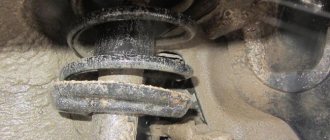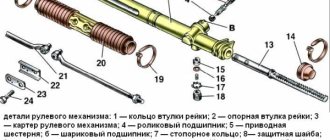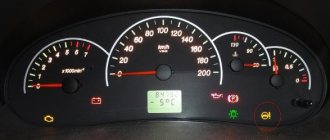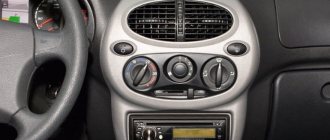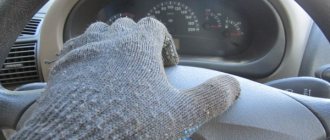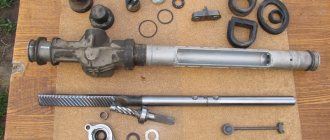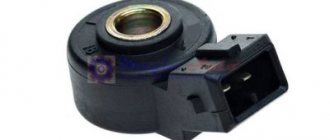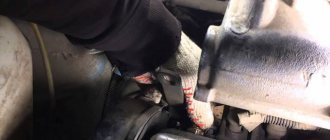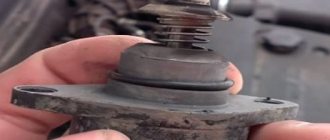The steering cross member plays an important role in driving a car; it is responsible for transmitting the rotation of the wheel to the rack assembly through the steering shaft cardan (the cross member itself is attached to it). Its correct operation depends not only on driving comfort, but also on the safety and health of all passengers. If the car has driven more than 100 thousand kilometers, most likely it needs repairs; it is worth studying in advance the question of when and how to change the cross member on the steering cardan.
Removing the electric power steering column
We set the wheels to the position of straight-line movement of the car.
Disconnect the wire terminal from the negative terminal of the battery. Remove the steering wheel (see “Removing the steering wheel”). We remove the steering column switches (see “Removing the steering column switches”). Disconnect the ignition switch wire connectors from the instrument panel wiring harness connectors. If necessary, remove the ignition switch from the steering column (see “Removing and disassembling the ignition switch”) Use a Phillips screwdriver to unscrew the three screws.
. and remove the lower cross member of the instrument panel.
By pressing the clamps, disconnect the two wiring harness blocks from the power steering control unit. Disconnect the wiring harness block from the connector of the steering column switches (see “Removing the steering column switches”).
Using a high “13” head, unscrew the four nuts securing the bracket (the fourth nut is not visible in the photo).
. and lower the column to the floor. If necessary, remove the connector for the steering column switches (see “Removing the steering column switches”).
Using a 13mm socket, unscrew the nut of the bolt securing the lower cardan joint to the steering gear shaft. If the bolt turns, hold it with a 13mm wrench.
Using a powerful slotted screwdriver, release the terminal connection of the hinge.
. and remove the intermediate propeller shaft from the steering gear shaft. Before disconnecting the intermediate propeller shaft from the steering shaft, use a marker to mark the relative position of the upper joint of the propeller shaft relative to the steering shaft.
Using a 13mm wrench, unscrew the nut of the hinge coupling bolt. If the bolt turns, hold it with a 13mm wrench. We take out the bolt
Use a screwdriver to loosen the terminal connection of the hinge.
. and remove the intermediate driveshaft from the steering shaft.
Intermediate cardan shaft
Install the intermediate driveshaft in reverse order. When connecting the upper joint of the intermediate propeller shaft to the steering shaft, it is necessary to align the previously made marks. Install the steering column in the reverse order. Installation this way is best done with an assistant. However, it is more convenient to install the column when the lower hinge of the intermediate propeller shaft is installed on the steering gear shaft in advance. To do this, after connecting the intermediate propeller shaft to the steering shaft...
. Using a 13mm wrench, unscrew the nut of the intermediate shaft coupling bolt. . remove the bolt.
. and disconnect the lower universal joint from the upper one. We install the lower hinge on the steering gear shaft (the bolt securing the hinge to the gear shaft should be located vertically on the right side). We turn the steering shaft so that the hole in the upper hinge for the intermediate shaft pinch bolt is located horizontally at the bottom of the shaft. We connect the upper and lower hinges of the intermediate shaft, insert the coupling bolt and tighten the nut. We carry out further installation in reverse order.
Replacing the steering shaft in Lada Kalina
One of the largest Russian enterprises involved in the development of passenger cars is AvtoVAZ. During the period when AvtoVAZ existed, many cars have already been produced and released. One of the released models is the VAZ1118, and this is the very first version of the Lada Kalina. The first Lada Kalina model began production in 2004 and ended in 2011. Although the production of this car model ceased a couple of years ago, the car itself did not disappear from Russian roads and they are still found on the roads of many Russian cities.
Prototypes of “Lada Kalina”
Lada Kalina 1119 hatchback
The first generation of the Lada Kalina model is the Lada Kalina 1119 hatchback, produced from 2006 to 2013 inclusive. The presented Lada Kalina prototype, compared to the sedan and station wagon, has an insufficiently large trunk volume, but if you fold the rear seats, you can carry a fairly large load. There are three basic configurations of this model: luxury, normal and standard. The luxury package includes improved velor upholstery of door panels and seats.
The engine has an eight-valve engine with a volume of 1.6 liters and a modern sixteen-valve unit with a volume of 1.4 liters. Its production began in 2007.
Lighter pistons, cylinder heads, steel intake manifold gaskets and extended connecting rods were used here. Thanks to the modern engine, the Lada Kalina has become more dynamic.
Lada Kalina 1118 sedan
Since 2004, the Lada Kalina model with a sedan body began to be produced, and in 2011, production of the four-wheel drive car ceased. The wheelbase and spacious interior of the sedan are no different from the station wagon and hatchback, and in terms of luggage compartment volume the sedan ranks first. In 2007, the car model received an improved sixteen-valve engine with a lightweight connecting rod and piston group.
Steering shaft cardan Lada Kalina
Lada Kalina 1117 station wagon
Mass production of the station wagon began in 2007, and in 2009 the Lada Kalina was improved. The luggage compartment volume of a station wagon is larger compared to a hatchback and smaller compared to a sedan. The engine has an eight-valve engine with a volume of 1.6 liters and a modern sixteen-valve unit with a volume of 1.4 liters. Reducing engine displacement made the Lada Kalina much more economical and dynamic. There are three basic configurations of this model: luxury, normal and standard.
Steering shaft
The steering shaft provides the connection between the steering wheel and the steering mechanism. Quite often a joint steering shaft is used. Thanks to it, the level of driver injuries in the event of an emergency is reduced.
Positive qualities of the steering shaft:
- Silence. Due to the absence of play in the universal joint with elastic bushings, silent operation occurs;
- There is no jamming and ease of rotation is noticeable, thanks to the presence of high-quality lubrication and the high anti-friction properties of the cardan bushings;
- Excellent elasticity of the cardan bushings, and this guarantees long-term use.
Replace the lower steering shaft driveshaft
- Open-end wrench 12;
- Hammer;
- Ratchet wrench with heads 10 and 12;
- Chisel;
- A slotted screwdriver with a thick and wide blade;
- Mount.
So, how to change the steering shaft driveshaft on a Kalina?
To replace the Kalina steering shaft driveshaft, you need to follow these steps:
- Align the wheels in the direction of straight-line movement of the car;
- Remove the cover from the corrugated air filter;
- Unscrew the 12mm bolt at the pedal assemblies;
- Unscrew the 12mm bolt in the hood area;
- By tapping on the ears of the cardan with a hammer, it is necessary to knock the cardan towards the steering wheel;
- Remove the cardan from the rack shaft;
- Using a 10mm socket, unscrew the engine shield bolts and slide the casing up the cardan;
- Using a pry bar, push the cardan up along the shaft splines;
- Pull the driveshaft down and remove it from the steering shaft;
- Place the boot on the new cardan;
- Insert a new cardan through the engine shield casing into the passenger compartment;
- In the cabin, you should get the universal joint into the upper universal joint of the steering rack;
- Place the steering wheel straight and place the cardan on the rack shaft;
- Tighten the bolts.
Identifying possible causes of knocking
Turning the steering wheel of front-wheel drive cars involves many joints, levers and rubber seals. A knocking sound in the steering wheel when turning may indicate wear of components or parts.
First of all, the assistant can turn the steering wheel, and you can listen to sounds under the car. Sometimes it is difficult to determine a breakdown by hearing, so you can touch various parts with your hand.
Wheel arch protection
One of the common causes of knocking is loosening of the wheel arch protection. In this case, it first turns under the action of the wheel, then returns to its original position, which gives rise to a characteristic “plastic” sound. Reliable fixation of the plastic protection takes a few minutes.
Hinges
Knocking when turning wheels can be generated by hinge joints: steering tips and rods, earrings and stabilizer rods. The noise occurs when a dirty or unlubricated joint jams. Sometimes it is enough to lubricate it, sometimes it is necessary to replace it.
A metallic crack that accompanies a full turn of the steering wheel may indicate a breakdown of the constant velocity joint, or in popular parlance, a “grenade”. A cracking sound when turning in both directions means that both “grenades” need to be replaced. Failure of CV joints is usually associated with a rupture of the rubber boot that protects the mechanism body. Even a small tear is enough to create the need to replace one of the most expensive components of the chassis. Therefore, it is better to check the anthers once a month for damage.
Silent blocks and ball joint
Noise can be caused by heavily worn-out rubber silent blocks and ball joints. In this case, when the wheels turn, the lever becomes skewed, which generates the sound.
Front pillar
If the steering wheel of a stationary car knocks when turning, then very often this means a breakdown of some part of the front strut. Some of these faults can be found directly, others can be found by dismantling and disassembling the rack.
Recommendations
Comments 132
Greetings. Why was the crosspiece 1640 chosen and not 1639? Yours seems to be recessed inside?
Doesn't matter. There is no point in installing a crosspiece, just insert it with caprolon. Then the cardan moves without knocking
Thanks to the author for a detailed and intelligible description of this operation; without these instructions, I would not have even tried to modify this unit. Respect! However, below I describe my first impressions of the result.
Well, I finally decided to install 2 steering joint crosspieces. I did it in two stages with a break of several days. After replacing the top one, I didn’t feel any results at all. But after all the work was completed, the first thing I noticed was that the steering wheel began to turn more tightly, perhaps it will develop over time. Secondly, squeaks appeared when turning the steering wheel; until the interior warmed up, they did not disappear. Third, the strumming became, of course, less, but still they remained in the area of the EUR (?), as well as a small play there. In terms of improving handling, I haven’t figured it out yet; I haven’t driven it on the highway yet; perhaps a tighter steering wheel will have its effect (like a damper). Something like that.
Interesting topic. Is the knock of the driveshaft critical? I just got it, so far it doesn’t bother me.
PPC, don’t you really notice how it affects the steering? You immediately start catching the car all the time!
Alternatively, you can change the car and that’s it
I’ll tell you my story about how my original driveshaft rattled on a grant, I bought a new one, supposedly reinforced enough for 3 months, it rattled, I took Ty and drove it through the fall and winter, a backlash gradually appeared, it reached the point of knocking, the ss20 painted head from a hairy hat and didn’t drive for a month rattled, as for me it’s all SS20 product hat (not anti-advertising), I re-tuned the original cardanic twice, one dick, don’t set the tolerance too tight, they start to play, the only thing is that they don’t knock, since I tried everything, I bought two Toyo 1638 crosses, we’ll re-tulit and see what happens.
I don’t know anything better than caprolon bushings yet
The bushings don't knock, but they do play over time, I don't like play in the steering
They play much less than everyone else.
And what kind of caprolon they took, white or black, they say black is stronger and lasts longer, I couldn’t find the black one that was ground from white.
In this case, white or black does not matter.
How are the bushings now? Is it worth betting?
I installed the SS20 on Kalina, drove the knock for up to a year and appeared there. Replaced under warranty! The other set ran without problems. Where can I get such material?
This is a bad cross. I also took GMB, enough for 2000 km. Take TOYO 1638. The quality is awesome, it’s been around for a little over 2 years, the crosspiece is like new, it doesn’t play, doesn’t knock, in short, I forgot about it. and size 1638 so that the edges could be sealed, I took 1640 so it fit along the edge, I had to weld the edges. I took it from the autodoc, this is not an advertisement. In a small auto shop I saw it was a fake and didn’t buy it.
I'll take note. I'll put in all the cardan shafts now. Bushings run better than bearings, tested with taxi drivers.
This is a bad cross. I also took GMB, enough for 2000 km. Take TOYO 1638. The quality is awesome, it’s been around for a little over 2 years, the crosspiece is like new, it doesn’t play, doesn’t knock, in short, I forgot about it. and size 1638 so that the edges could be sealed, I took 1640 so it fit along the edge, I had to weld the edges. I took it from the autodoc, this is not an advertisement. In a small auto shop I saw it was a fake and didn’t buy it.
How long have you driven the TOYO 1638?
It's been about 60 thousand, and it's still there (no play).
Listen, why 1638 and not 1639, these seem to be the dimensions. Or is it not important?
Quick Guide
The main reason for tapping is the formation of a gap in the joints. In the steering system, there may be knocking on the tips, ball joints of the rods, the rack, the “cardan” in the column, the steering wheel on the shaft, or the auto-folding system in case of an accident. The metallic sound is distinct and can be heard in place when rocking the steering wheel.
It is quite possible to mistake problems in the suspension for problems in the steering, since the initial stages of wear of bearings and supports only make themselves felt when cornering at speed. In the suspension part, the cause of the knock should be sought in the wheel bearings, ball joints and “supports”.
Car owners often encounter a problem: when turning in one or both directions, an unpleasant and disturbing sound is clearly heard. There may be several reasons. To independently find and eliminate the malfunction indicated by a knocking sound when turning the steering wheel, you need consistent diagnostics of the chassis.
Almost every driver has encountered a knocking sound when turning the steering wheel.
How to change the steering cardan
The steering crosspiece is the key to the control of the car; it is responsible for transmitting the rotation of the wheel to the rack and pinion assembly through the steering shaft cardan (the crosspiece itself is attached to it). Not just the ease of driving, but the safety and health of all passengers depends on its correct functioning. If the car has been in use for more than 100 thousand kilometers, it most likely needs repairs; it is worth studying in advance the question of when and how to change the crosspiece on the steering cardan.
How to fix
The main reason for knocking is that the cardan located at the bottom of the engine shield is weakened.
The second driveshaft is not visible; it is located behind the cover of the electric power steering control unit. To make it easier to tighten and see the mechanism, you need to remove the steering wheel cover. The photo shows the electric amplifier and its electronics unit.
I removed the metal box that is held in place with screws. They were tightened very tightly; I had to use a special power screwdriver with a ratchet. Behind it you can see the second cardan, on which you need to check the tightness, which I did.
Surprisingly, nothing was loosened after 45 thousand miles. On other cars with lower mileage, the driveshafts usually weaken earlier.
Within a few minutes you can get rid of the knocking sound of the steering gearbox. Of course, this will not help in all cases. But before tightening the rack, try checking the cardans.
Write how you eliminated extraneous noise, squeaks and knocks. What was their reason and what happened. I wish you good luck and goodness!
How do you know when it's time to change the driveshaft?
Signs of its malfunction are noticeable, but have little effect on the quality of movement, which is why many car owners ignore the problem until the last moment, almost to the point of losing control of the car. You should not ignore signs of a malfunction; if at least two appear at once, you need to immediately carry out diagnostics. What are the signs of wear or breakage?
- When driving at a speed of more than 80 km/h, the steering wheel resists when turning, making it more difficult to turn.
- The steering wheel turns unevenly and jerks when turning, which puts additional stress on the hands.
- The steering wheel has become less sensitive, and the turning of the wheels responds to control late.
- The appearance of noticeable play (free movement of wheels with stable fixation of the steering wheel).
- Vibration of the driveshaft. Check with a tachometer to see if this vibration appears at one speed or at different speeds. Only vibration at different speeds indicates problems with the cardan; if it occurs at different speeds, but at the same frequency, then you need to think about how to change the steering cardan on a grant, because the speed of the cardan was different at that time.
- Knocking and grinding noises in the steering wheel, especially when driving on rough roads.
Signs of wear on the crosspiece
How the steering cardan works, a review of faults and instructions for replacing it.
Often, motorists do not pay attention to insignificant signs that it is time to make repairs, and wait until the problem makes itself known publicly and this is fraught with consequences, especially when it comes to loss of vehicle control.
The first signs of wear on the crosspiece appear as:
- the presence of noticeable resistance to the steering wheel when rotating at speeds above 80 km/h;
- delayed wheel turning and loss of sensitivity (delayed response of wheels and steering shaft);
- increased free play angle of the wheels (popularly this symptom is also called “Steering play”);
- uneven rotation of the steering wheel, the steering wheel moves with sharp jerks;
- obvious grinding or knocking noise that occurs when the steering wheel is rotated; the grinding becomes especially noticeable and obvious on an uneven road.
Most often, motorists turn to a car service center to replace the steering shaft crosspiece mechanism only when the last sign of a malfunction appears, but in vain, because in the event of an emergency, the steering control will not be able to adequately respond to the driver’s efforts, and sometimes, the steering control may even fail, this is already fraught with very big troubles.
Repair of the shaft cross is carried out every 50 - 100 thousand, it is better more often, otherwise it will have to be completely replaced with a new one.
To replace, you will need to purchase a crosspiece - on average 150-300 rubles, some car services claim that for the steering to work correctly, you need the entire steering shaft (4 - 7 thousand rubles), but on most cars it is enough to change only the crosspiece.
How to change the steering cardan
- It is better to roll the car into a pit (at least raise it in front of the car).
- Fix the steering wheel and steering wheel at a right angle. You should also not move or touch the wheels during repairs.
- Remove the front wheel, then unscrew the mounting bolt through the interior. If all operations are carried out correctly, the shaft should come off the steering wheel on its own.
- Remove both casings (top and bottom), make sure there is a boot on the steering shaft. If it is not there, it is better to install it after repair; the part costs no more than 200 rubles.
- Unscrew the bolt on the crosspiece, then the shaft will come off the steering rack on its own.
- Pull down and pull out the shaft. Before repairing, it is better to wash it from dirt and rust; it also affects the quality of movement.
- Secure the shaft in a vice. When it is secured, take the head and knock out the cross on one side to remove the bearing cup. Repeat the same action from the other end.
- Insert a new cross in the same order (one at a time on each side).
- Press in a new crosspiece with a vice (do not overpress).
- Align the cups and roll them with a hammer and chisel.
- Install the new part on the car in reverse order.
Many car owners note when they are looking for where and how to change the steering joint on a Toyota that steering crosspieces from the VAZ-2015 are very suitable for this brand. This greatly simplifies the process of finding parts and reduces the overall cost of repairs.
If we are talking about repairing a “workhorse”, a vehicle engaged in transportation or cargo transportation, repairs or replacements have to be made more often than once every 100 thousand km (due to the condition of most of the roads). Experienced craftsmen who give advice on how to change the driveshaft on the steering wheel of a gazelle note that it is better to install two boots at once so that the sound from the engine is quieter. At the same time, the anthers themselves can also be sealed with foam rubber rings, this significantly reduces squeaks and noise in the car interior.
The driveshaft part itself will cost from 650 rubles for domestic cars and higher for foreign cars. Plus - consumables in the form of boots and nuts.
Tie rods and tie rods
If the tips or the tie rods themselves begin to knock, as a rule, they have to be changed. As for the diagnosis of these elements, experienced drivers carry it out independently. To do this, you need to wobble the tip and the rod itself, but you need to know how, what, and in what direction to wobble. If the steering tips or steering rods are knocking, then in the first case, replacement is required, in the second, options are possible, for example, replacing the steering rod silent blocks. But it is very likely that the thrust will still have to be changed.
With significant wear, the ball joint of the wheel can also generate extraneous sounds when turning the steering wheel. The most important element for long service life of ball joints, as well as CV joints and steering ends, is regular inspection and replacement, if necessary, of their boots. It is the anthers that protect these components from dirt, water, lubricant leakage and other negative phenomena. And if you change the boots on time, both ball and CV joints, and actually the steering ends, last quite a long time.
Why might the driveshaft break?
The most common reason is constant use of the car on uneven roads, driving over potholes and ruts. During such shaking, a large load falls on this moving part.
The second reason may be oil leakage due to a leaking oil seal. Because of the oil, the sealing ring https://podshipnik-mo.ru/koltsa-uplotnitelnyye hardens, and a gap appears between the oil seal and the rod. Or the mirror on the driveshaft connection is broken, and various roughness and burrs appear on the rod. In this case, the splines will have to be changed or sanded (but this is a temporary remedy).
Other causes of knocking noise when turning the steering wheel
These reasons include different degrees of wheel inflation, which due to inexperienced drivers is not so rare. In addition, in rear-wheel drive cars, the cardan may knock and problems should be looked for in this unit. However, first of all, you need to check the above components, because most often they generate extraneous noise when turning the steering wheel.
If we summarize all of the above and give advice to beginners, we can say that a very important and effective prevention of the appearance of extraneous noise in a car, as well as the breakdowns that give rise to these noises, is to care for the car, regularly inspect it not only from the side and from above, but and from below, as well as careful and reasonable driving, especially at speed, especially on our roads. In this case, you will be able to drive for a long time and no extraneous noise will bother you. Although, of course, in due course you will have to change the steering tips, ball joints, CV joints and other components and assemblies of the car, because, alas, nothing lasts forever in this world.
Replacing the steering shaft in Lada Kalina
One of the largest Russian enterprises involved in the development of passenger cars is AvtoVAZ. During the period when AvtoVAZ existed, many cars have already been produced and released. One of the released models is the VAZ1118, and this is the very first version of the Lada Kalina. The first Lada Kalina model began production in 2004 and ended in 2011. Although the production of this car model ceased a couple of years ago, the car itself did not disappear from Russian roads and they are still found on the roads of many Russian cities.
Prototypes of “Lada Kalina”
Lada Kalina 1119 hatchback
The first generation of the Lada Kalina model is the Lada Kalina 1119 hatchback, produced from 2006 to 2013 inclusive. The presented Lada Kalina prototype, compared to the sedan and station wagon, has an insufficiently large trunk volume, but if you fold the rear seats, you can carry a fairly large load. There are three basic configurations of this model: luxury, normal and standard. The luxury package includes improved velor upholstery of door panels and seats.
The engine has an eight-valve engine with a volume of 1.6 liters and a modern sixteen-valve unit with a volume of 1.4 liters. Its production began in 2007.
Lighter pistons, cylinder heads, steel intake manifold gaskets and extended connecting rods were used here. Thanks to the modern engine, the Lada Kalina has become more dynamic.
Lada Kalina 1118 sedan
Since 2004, the Lada Kalina model with a sedan body began to be produced, and in 2011, production of the four-wheel drive car ceased. The wheelbase and spacious interior of the sedan are no different from the station wagon and hatchback, and in terms of luggage compartment volume the sedan ranks first. In 2007, the car model received an improved sixteen-valve engine with a lightweight connecting rod and piston group.
Downloading a book
Replacing the front struts of a Lada Kalina with your own hands
After successfully completing the payment (by any method) and returning to the KrutilVertel store from the payment system website, you will be taken to the successful payment page:
The book you purchased will be in your personal account, from where you can always download it.
Please note that after making the payment, you need to return back from the payment system website to the KrutilVertel website. If for some reason you did not return back to the site and closed the payment system tab with a message about the successful completion of the payment, please let us know - we will send you a letter indicating access to download the book
If for some reason you did not return back to the site and closed the payment system tab with a message about the successful completion of the payment, please let us know - we will send you a letter indicating access to download the book.
Steering shaft
The steering shaft provides the connection between the steering wheel and the steering mechanism. Quite often a joint steering shaft is used. Thanks to it, the level of driver injuries in the event of an emergency is reduced.
Positive qualities of the steering shaft:
- Silence. Due to the absence of play in the universal joint with elastic bushings, silent operation occurs;
- There is no jamming and ease of rotation is noticeable, thanks to the presence of high-quality lubrication and the high anti-friction properties of the cardan bushings;
- Excellent elasticity of the cardan bushings, and this guarantees long-term use.
Replace the lower steering shaft driveshaft
- Open-end wrench 12;
- Hammer;
- Ratchet wrench with heads 10 and 12;
- Chisel;
- A slotted screwdriver with a thick and wide blade;
- Mount.
So, how to change the steering shaft driveshaft on a Kalina?
To replace the Kalina steering shaft driveshaft, you need to follow these steps:
- Align the wheels in the direction of straight-line movement of the car;
- Remove the cover from the corrugated air filter;
- Unscrew the 12mm bolt at the pedal assemblies;
- Unscrew the 12mm bolt in the hood area;
- By tapping on the ears of the cardan with a hammer, it is necessary to knock the cardan towards the steering wheel;
- Remove the cardan from the rack shaft;
- Using a 10mm socket, unscrew the engine shield bolts and slide the casing up the cardan;
- Using a pry bar, push the cardan up along the shaft splines;
- Pull the driveshaft down and remove it from the steering shaft;
- Place the boot on the new cardan;
- Insert a new cardan through the engine shield casing into the passenger compartment;
- In the cabin, you should get the universal joint into the upper universal joint of the steering rack;
- Place the steering wheel straight and place the cardan on the rack shaft;
- Tighten the bolts.
